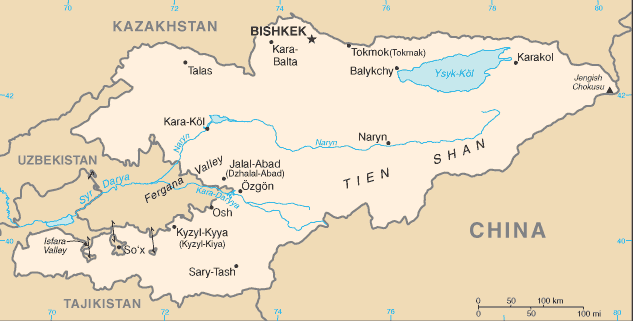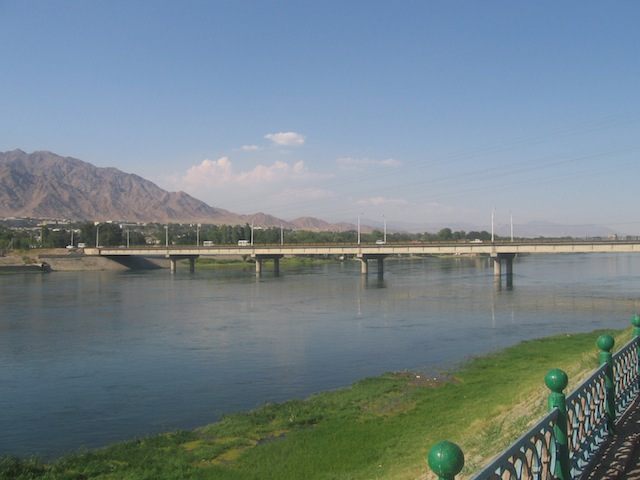This morning’s key headlines from GenerationalDynamics.com
- Violence flares in Central Asia’s Fergana Valley
- Brief generational history of Uzbekistan
- Rise of ISIS raises militant Islamist concerns in Central Asia
Violence flares in Central Asia’s Fergana Valley

Kyrgyzstan, which has disputed borders with both Uzbekistan in the Fergana Valley, and with Tajikistan in the Isfara Valley
Uzbekistan, Kyrgyzstan and Tajikistan have sent troops and officials to a Fergana Valley (or Ferghana Valley) border regions where there are violence is increasing in border disputes. Negotiations are ongoing to prevent the further spread of violence.
The densely populated Fergana Valley sits at the intersection of Uzbekistan, Tajikistan, and Kyrgyzstan. In 2009, I wrote about the rise of the al-Qaeda linked Islamic Movement of Uzbekistan (IMU), and about the importance of the Fergana Valley to the U.S. for Afghan war logistics. (See “Islamist Uzbeks lead terrorists in Pakistan and Afghanistan” from 2009.)
In 2010, there was extremely bloody violence in the Fergana Valley on the Kyrgyzstan side of the border. A U-shaped region stretching along the border between the cities of Osh and Jalalabad was devastated, causing hundreds of deaths, thousands of injuries, and hundreds of thousands of refugees. ( “15-Jun-10 News — Uzbekistan closes border to refugees from Kyrgyzstan”)
Almost all of the casualties were Uzbek victims of Kyrgyz violence, including violence by the Kyrgyz army. Some people blame Josef Stalin for the carnage because, in the 1920s and 1930s, Kyrgyzstan, Uzbekistan and Tajikistan were established as Soviet republics, and divided by arbitrary borders in the Fergana Valley. These arbitrary boundaries, which ignored ethnic realities, created the ethnic tensions and rivalries that are the basis of the current violence and atrocities that began occurring after the collapse of the Soviet Union in 1991.
In the last few weeks, violence has been flaring separately across Kyrgyzstan’s disputed borders with Uzbekistan and Tajikistan. Two days ago, there was a shootout along the border of Tajikistan and Kyrgyzstan, which resulted in the injury of six Tajiks. And in late June, an Uzbek border guard was wounded in a shootout on the border of Uzbekistan and Kyrgyzstan. Both food and water are available in the Fergana Valley, but not enough to meet the needs of local residents. As a result, residents are blocking roads and waterways that cross the disputed borders.
These conflicts are raising concerns that either or both might spiral out of control into a repeat of the 2010 violence around Osh and Jalalabad.
Unfortunately, there does not exist any durable solution to these border conflicts short of all-out war. Each of the ethnic groups — Uzbeks, Tajiks and Kyrgyz — has enclaves in all three countries where ancestors have been living for centuries, and ethnic hatred runs deep.
In the last century, population in the Fergana valley has increased five-fold. There is plenty of water in the valley, but still not enough for the rapidly growing population. Due to poverty and government corruption, the Fergana Valley is becoming a hotbed of discontent, led by Islamic radicals. Trend Agency (Azerbaijan) and The Diplomat and Strategy Page and Jamestown
Brief generational history of Uzbekistan
The Uzbeks are one of the many tribes that have populated Central Asia for centuries, and the wars they fought were mainly with one another until the Russians conquered the region in the late 1800s. Although the wars in Central Asia were primarily ethnic, it is worth noting that the residents are mostly Sunni Muslim, and the Russians are Orthodox Christian.
Uzbekistan’s last generational crisis war was World War I and the Bolshevik Revolution of 1917.
World War II thus occurred during a generational Awakening era for the Uzbeks. Thus the Uzbeks stayed out of the war, and in fact carried out a “humanitarian mission” during the war, by sheltering in their families the hundreds of thousands of refugees from the fascist occupied territories. There were hundreds of thousands of refugees from Russia, Ukraine, Baltic States, Poland, and other countries.
As part of Stalin’s Soviet Union, Uzbekistan became a cotton powerhouse starting in the 1920s. In support of the cotton trade, millions of ethnic Russians began pouring into the country, especially into the fertile Fergana Valley.
The old Uzbek / Russian fault line became critical again, starting in the 1980s with the Russian invasion of Afghanistan. At that time, Uzbek militants began joining the Pashtuns in Afghanistan to fight against the Soviets. When the Soviet Union collapsed in 1991, Uzbekistan became an independent republic. A consequence was a great deal of financial hardship for the Russians in the Fergana Valley. The result was the first signs of Islamic fundamentalism in Uzbekistan when some unemployed young Muslims seized the Communist Party headquarters in the city of Namangan in the Fergana Valley.
The leaders of this terrorist action, Tohir Yuldeshev and Juma Namangani, eventually made their way to Afghanistan in 1996, after the Taliban had taken control of the government. They joined Osama bin Laden and al-Qaeda, and formed the Islamic Movement of Uzbekistan (IMU). The IMU has been playing an important role in terrorist acts in Afghanistan and Pakistan.
Rise of ISIS raises militant Islamist concerns in Central Asia
While Central Asian countries have always been concerned about Islamist militancy, the rise of the self-described Islamic State (IS or ISIS or ISIL or Daesh) is raising concerns about new, more dangerous threats.
The International Crisis Group think tank estimates 4,000 people have traveled to Syria to join ISIS. The Islamic Movement of Uzbekistan (IMU) last week pledged allegiance to ISIS, only days after the death of the Taliban leader Mullah Omar was announced. These developments are raising fears of destabilization of the Central Asian countries.
As a result, authorities are taking draconian measures to stamp out militant Islam. Uzbekistan has banned beards, outlawed Islamic dress, shut restaurants that refuse to sell alcohol and warned teahouses not to celebrate the nightly end of the Ramadan fast with “Iftar” meals. In Kyrgyzstan, where the authorities vet preachers to ensure mosque sermons do not stir up unrest, there have been shootouts between the secret police and militants.
However, these harsh measures risk a backlash in the form of even more young Muslims traveling to Syria to join ISIS.
One researcher, who has interviewed ISIS militants in Central Asia, found that poverty was not the primary motivation for joining ISIS. Nor were they particularly knowledgeable about Islamic tenets for fighting in such a war (somewhat refuting the popular belief that jihadists are being trained in radical madrassas). Many joined for reasons of social justice — to help Muslim brothers, to fight a regime that oppresses them, to defend the weak. Others chose to join because of adventure, romanticism, love (especially women), their wish to become heroes, or just because they feel the caliphate is the right place for a good Muslim life and they want to contribute to its development. Reuters and Eurasia Net and The Diplomat
KEYS: Generational Dynamics, Central Asia, Fergana Valley, Ferghana Valley, Osh, Jalalabad, Soviet Union, Josef Stalin, Uzbekistan, Kyrgyzstan, Tajikistan, Islamic Movement of Uzbekistan, IMU, Namangan, Tohir Yuldeshev, Juma Namangani, Afghanistan, Pakistan, Islamic State / of Iraq and Syria/Sham/the Levant, IS, ISIS, ISIL, Daesh, Taliban, Mullah Mohammed Omar
Permanent web link to this article
Receive daily World View columns by e-mail

COMMENTS
Please let us know if you're having issues with commenting.